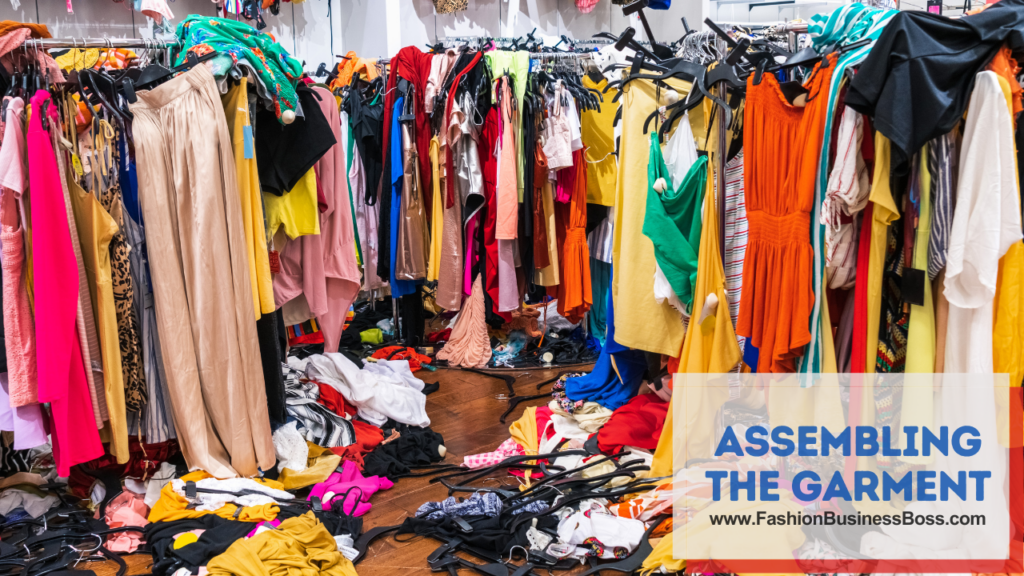There’s a growing desire among individuals to express their unique style and creativity. Making your own designer clothes is an incredibly fulfilling and sustainable way to stand out in the crowd, while also embracing your inner artist.
Here are some essential steps to make your own designer clothes: Find inspiration, choose the right materials, create design sketches, master sewing techniques, and add unique embellishments. Crafting your style has never been more fulfilling.
In this article, we will walk you through the steps of creating your own unique clothing designs.
Finding Your Design Inspiration

The journey to making your own designer clothes begins with finding your unique creative voice. Your designs should reflect your personality, interests, and experiences. Start by identifying what inspires you – it could be art, nature, music, or even emotions. Keep a journal of your ideas, sketches, and concepts to help you tap into your creative side whenever you need.
To cultivate your inspiration, immerse yourself in the world of fashion and art. Visit museums, galleries, fashion shows, and exhibitions to broaden your perspective. Follow fashion designers, influencers, and trendsetters on social media platforms to stay updated with the latest fashion trends. Travel and explore different cultures and styles, as this can be a rich source of inspiration.
A mood board is a visual representation of your design ideas. Collect images, fabrics, colors, and textures that resonate with your vision and pin them on a physical board or create a digital one. This tool will help you solidify your design concept and guide your fabric and color choices. It’s a useful reference throughout your design process.
Read more about: Dressing Up Your Brand: Steps to Get Your Own Clothing Label
Materials and Tools
Before you start designing, it’s crucial to have a good understanding of different types of fabrics. Fabrics vary in weight, texture, drape, and stretch, which will greatly impact your design. Common fabrics include cotton, silk, wool, linen, and synthetic blends. Choose the one that suits your design concept and the garment’s intended use.
The right fabric choice can make or break your design. Consider factors such as comfort, durability, and ease of sewing when selecting your fabric. If you’re a beginner, it’s wise to start with easy-to-sew fabrics like cotton or denim. As you gain confidence, you can experiment with more challenging materials.
Equipping yourself with the right tools is essential for a smooth sewing experience. Basic sewing tools include sewing machine, scissors, pins, needles, measuring tape, chalk, and a seam ripper. Depending on your design, you might also need specialized tools like a serger, embroidery machine, or dress form. Make sure to invest in quality tools to ensure the longevity of your sewing journey.
Creating Design Sketches
Your sketches are the blueprints of your designs. You don’t have to be a professional artist to create effective design sketches. Start with simple, clear drawings that convey your ideas. Don’t worry about perfection at this stage; it’s about capturing your vision on paper.
Include important details on your sketches, such as measurements, fabric choices, and any special instructions. This will serve as your reference when you’re ready to cut and sew. Precision is key in achieving a professional finish.
As you accumulate more design ideas, consider creating a cohesive collection. Think about how your designs can work together to tell a story or convey a specific theme. A well-curated collection can make a stronger impact when presenting your work.
Pattern Making

To create a garment, you’ll need a pattern. Start by drafting a basic block pattern, which is a blueprint for your designs. It serves as the foundation upon which you’ll build your creations. Follow pattern-making tutorials or take classes to learn this fundamental skill.
Once you have your block pattern, it’s time to design your garment-specific pattern. Use your sketches as a reference and modify the block pattern accordingly. Make sure your pattern includes all the necessary pieces, like sleeves, collars, and pockets.
Fit is crucial in fashion design. To achieve a well-fitting garment, make test samples, and adjust your pattern as needed. This may require multiple iterations, but it’s essential for creating a piece that fits comfortably and looks flattering.
Read more about: E-Commerce Essentials: Launching Your Clothing Business Online
Choosing the Right Sewing Techniques
Sewing is a diverse craft with various techniques to learn. Straight stitching, zigzag stitching, French seams, and topstitching are just a few examples. Each technique serves a specific purpose, so it’s essential to know when and how to use them in your projects.
The type of stitch and seam you use will depend on the fabric and design of your garment. For instance, you might use a straight stitch for woven fabrics and a zigzag stitch for knits. Experiment with different stitches and seams to achieve the best results.
Hemming your garment, attaching zippers, and sewing on buttons are essential finishing touches. These details may seem minor, but they can make a significant difference in the overall appearance of your creation. Learn these techniques to ensure a polished final product.
Sewing Machine Mastery
Before you start sewing, become familiar with your sewing machine. Read the manual, learn to thread the machine correctly, and practice sewing on scrap fabric. Adjust settings like stitch length and tension to match the requirements of your project.
Practice makes perfect, especially when it comes to sewing. Begin with simple projects to build your skills, then gradually move on to more complex designs. Pay attention to details like seam allowances, and strive for clean, straight stitching.
Sewing machines can encounter issues like thread tension problems, thread bunching, or needle breakage. Knowing how to troubleshoot and fix these problems will save you time and frustration. Keep your machine clean and well-maintained to prevent issues from occurring.
Assembling the Garment

Lay out your fabric and carefully cut out your pattern pieces. Use pattern weights or pins to secure the pattern pieces in place while you cut. Double-check your measurements and markings to ensure accuracy.
Start sewing your garment according to your pattern instructions. As you progress, frequently try on the partially completed garment to check for fit and comfort. Don’t hesitate to make adjustments as needed. It’s common for initial fitting to require some alterations, so patience is key.
After your garment is sewn together, it’s time for the final touches. These include adding trims, labels, or any other embellishments to make your design unique. Take your time with these details to ensure a professional and polished look.
Read more about: E-Commerce Essentials: What Does It Cost to Make a Clothing Website?
Embellishing Your Creation
Embellishing your clothes is a fantastic way to make them truly unique. You can use embroidery to add intricate designs, appliqué to attach fabric patches, or beadwork for a touch of glamour. These techniques allow for endless creativity and personalization.
Custom prints and patches can be an excellent way to showcase your individuality. You can design and print your own fabric patterns, or source unique patches to attach to your garments. This method allows you to create limited-edition pieces that truly represent your style.
Texture plays a vital role in fashion. Experiment with different fabrics, layering techniques, and embellishments to create depth and visual interest in your designs. Mixing textures can be a creative way to add complexity to your creations.
Caring for Your Handmade Clothes
To ensure the longevity of your handmade garments, it’s essential to follow proper care instructions. Always read and adhere to fabric care labels. Hand wash delicate items and use a gentle cycle for others. Proper storage, such as hanging or folding, can prevent wrinkles and damage.
No matter how well-made your clothes are, wear and tear may occur over time. Learn basic sewing repair techniques to mend small rips, loose buttons, or loose hems. Regular maintenance, such as checking for loose seams, can extend the life of your garments.
Creating your own clothes also empowers you to make them with quality and durability in mind. Invest in high-quality fabrics and construction techniques to ensure your designs stand the test of time. This sustainable approach to fashion helps reduce the environmental impact of fast fashion.
Showcasing Your Creations

If you’re passionate about fashion and plan to share your creations with the world, consider building a personal brand or a small fashion label. Create a unique name, logo, and online presence to promote your designs and connect with your target audience.
A well-crafted portfolio or lookbook is essential when showcasing your designs to potential clients, collaborators, or buyers. Include high-quality images of your work, along with descriptions and inspiration behind each piece. A professional presentation can make a significant impact.
Consider selling your designs through online platforms, local boutiques, or at craft fairs and exhibitions. Building a customer base takes time, so patience and persistence are key. Alternatively, you can display your creations in art galleries, fashion shows, or even your own fashion events to gain exposure and recognition.
Read more about: Elegance in Pixels: Design Your Clothing Website
Tips and Troubleshooting
From sewing mishaps to design errors, everyone makes mistakes. The key is to learn from them and keep improving. Understanding common mistakes in fashion design and how to avoid them can save you time and frustration in the long run.
In an era of increasing environmental awareness, consider sourcing sustainable materials for your creations. Look for eco-friendly fabrics, and consider upcycling or recycling materials whenever possible. Sustainable practices not only benefit the planet but also appeal to socially conscious consumers.
Fashion design is a journey that requires dedication and persistence. There may be moments of self-doubt, creative blocks, and frustration. Stay motivated by setting goals, joining sewing groups or workshops, and celebrating your accomplishments along the way. Consistency is the key to mastering your craft.
Conclusion
Your fashion creations are a reflection of your individuality. Celebrate your unique style and share it with the world. Whether you create clothing for yourself, your loved ones, or a broader audience, your designs have the power to inspire and empower others to embrace their creativity.
Frequently Asked Questions

Q: How can one initiate the process of making their own designer clothes?
A: Initiating the process involves seeking inspiration from various sources, gathering essential tools and materials, and acquiring fundamental skills in sketching, pattern making, and sewing.
Q: What are the critical considerations when selecting fabric for a design?
A: It’s important to evaluate the fabric’s weight, drape, and stretch, as well as its suitability for the intended design. Factors such as comfort, durability, and ease of sewing should also be taken into account.
Q: What strategies can be employed to maintain the longevity of handmade clothing?
A: To extend the lifespan of handmade garments, it is advisable to follow care instructions, perform regular inspections for damages, and acquire basic sewing repair skills. Utilizing high-quality materials and sustainable practices also contributes to the longevity of designs.
Q: Can you recommend resources for learning the basics of sketching and pattern making for designing clothes?
A: Yes, there are numerous online tutorials, books, and classes that can help beginners learn the fundamentals of sketching and pattern making. Websites like Skillshare and Udemy offer courses on these topics. You can also find helpful books at your local library or bookstore.
Q: What are some common sewing machine problems, and how can they be resolved?
A: Common sewing machine problems include thread tension issues, thread bunching, and needle breakage. To resolve these, start by rethreading the machine, ensuring it’s correctly threaded through the tension discs. For thread bunching, check the bobbin and upper thread tensions. Needle breakage can often be prevented by using the correct needle type for your fabric. If problems persist, consult your sewing machine’s manual or seek assistance from a professional. Regular maintenance, such as cleaning and oiling, can also prevent many issues.
To learn more about starting your own clothing business, check out my startup documents here.
Please note that the contents of this blog are for informational and entertainment purposes only and should not be construed as legal advice. Any action taken based on the information provided in this blog is solely at your own risk. Additionally, all images used in this blog are generated under the CC0 license of Creative Commons, which means they are free to use for any purpose without attribution.

Meet Shawn Chun: Entrepreneur and Fashion Business Fan.
I’m a happy individual who happens to be an entrepreneur. I have owned several types of businesses in my life from a coffee shop to an import and export business to an online review business plus a few more and now I create online resources for those interested in starting new ventures. It’s demanding work but I love it. I do it for those passionate about their business and their goals. That’s why when I meet a designer or boutique owner at a craft fair, farmers market, retail location or anywhere else I see myself. I know how hard the struggle is to retain clients, find good employees and keep the business growing all while trying to stay competitive.
That’s why I created Fashion Business Boss: I want to help fashion business owners like you build a thriving business that brings you endless joy and supports your ideal lifestyle.

